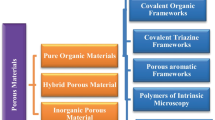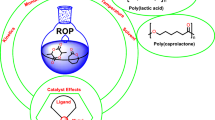Abstract
An original approach to the synthesis of a new promising class of thermo-sensitive polymers, polymer brushes with regularly alternating grafted poly(2-alkyl-2-oxazoline) chains (PAOx), is proposed based on the "grafting through" scheme. At first, poly(2-alkyl-2-oxazoline) macro-monomers were obtained with styrene and maleimide terminal functions by the cationic ring-opening polymerization of 2-ethyl- and 2-isopropyl-2-oxazolines. Then, polymer brushes (PAOx-PB) with alternating-side polyoxazoline chains were synthesized via radical polymerization in chlorobenzene solution initiated by azobisisobutyronitrile. Reactivity ratios of the macro-monomers were determined by the Fineman–Ross (r1 = 0.013; r2 = 0.107) and the Kelen–Tüdős (r1 = 0.012; r2 = 0.105) methods, indicating that their copolymerization results in the formation of a polymer brush with an alternating sequence of macro-monomer units in the backbone. Molecular weight characteristics of obtained PAOx-PB were determined by means of size-exclusion chromatography and static light-scattering. The resulting PAOx-PB have unimodal molecular weight distribution, a rather low degree of polymerization of the main chain and the number of side chains in the range of fSC = 10–20. The structure and monomer content of synthesized PAOx-PB were studied using 1HNMR spectroscopy. It was shown that they have equivalent contents of PEtOx and PIPrOx side chains. The high intramolecular density of PAOx-PB macromolecules and, accordingly, the strong folding of the side chains was indicated.
Graphical abstract








Similar content being viewed by others
Data availability
The data that support the findings of this study are available as the Supplementary Information file.
References
Philippova OE, Khokhlov AR (2010) Smart polymers for oil production. Petr Chem 50:266–270. https://doi.org/10.1134/S0965544110040031
Jochum FD, Theato P (2013) Temperature- and light-responsive smart polymer materials. Chem Soc Rev 42:7468–7483. https://doi.org/10.1039/C2CS35191A
Weber C, Hoogenboom R, Schubert US (2012) Temperature responsive bio-compatible polymers based on poly(ethylene oxide) and poly(2-oxazoline)s. Prog Polym Sci 37:686–714. https://doi.org/10.1016/j.progpolymsci.2011.10.002
Takahashi R, Sato T, Terao K, Qiu XP, Winnik FM (2012) Self-association of a thermosensitive poly(alkyl-2-oxazoline) block copolymer in aqueous solution. Macromolecules 45:6111–6119. https://doi.org/10.1021/ma300969w
Vlassi E, Papagiannopoulos A, Pispas S (2017) Amphiphilic poly(2-oxazoline) copolymers as self-assembled carriers for drug delivery applications. Eur Polym J 88:516–523. https://doi.org/10.1016/j.eurpolymj.(2016).10.034
Schulz A, Jaksch S, Schubel R, Wegener E, Di Z, Han Y, Meister A, Kressler J, Kabanov AV, Luxenhofer R, Papadakis CM, Jordan R (2014) Drug-induced morphology switch in drug delivery systems based on poly(2-oxazoline)s. ACS Nano 8:2686–2696. https://doi.org/10.1021/nn406388t
Schenk V, Rossegger E, Ebner C, Bangerl F, Reichmann K, Hoffmann B, Höpfner M, Wiesbrock F (2014) RGD-functionalization of poly(2-oxazoline)-based networks for enhanced adhesion to cancer cells. Polymers 6:264–279. https://doi.org/10.3390/polym6020264
Schlaad H, Diehl C, Gress A, Meyer M, Demirel AL, Nur Y, Bertin A (2010) Poly(2-oxazoline)s as smart bioinspired polymers. Macromol Rapid Commun 31:511–525. https://doi.org/10.1002/marc.(2009)00683
Xie G, Martinez MR, Olszewski M, Sheiko SS, Matyjaszewski K (2019) Molecular bottlebrushes as novel materials. Biomacromol 20:27–54. https://doi.org/10.1021/acs.biomac.8b01171
Banquy X, Burdyńska J, Lee DW, Matyjaszewski K, Israelachvili J (2014) Bioinspired bottle-brush polymer exhibits low friction and amontons-like behavior. J Am Chem Soc 136:6199–6202. https://doi.org/10.1021/ja501770y
Johnson JA, Lu YY, Burts AO, Xia Y, Durrell AC, Tirrell DA, Grubbs RH (2010) Drug-loaded bivalent-bottle-brush polymers by graft-through ROMP. Macromolecules 43:10326–10335. https://doi.org/10.1021/ma1021506
Zheng W, Anzaldua M, Arora A, Jiang Y, McIntyre K, Doerfert M, Winter T, Mishra A, Ma H, Liang H (2020) Environmentally benign nanoantibiotics with a built-in deactivation switch responsive to natural habitats. Biomacromol 21:2187–2198. https://doi.org/10.1021/acs.biomac.0c00163
Li X, Prukop SL, Biswal SL, Verduzco R (2012) Surface properties of bottlebrush polymer thin films. Macromolecules 45:7118–7127. https://doi.org/10.1021/ma301046n
Sheiko SS, Sumerlin BS, Matyjaszewski K (2008) Cylindrical molecular brushes: synthesis characterization and properties. Prog Polym Sci 33:759–785. https://doi.org/10.1016/j.progpolymsci.2008.05.001
Laroque S, Reifarth M, Sperling M, Kersting S, Klöpzig S, Budach P, Storsberg J, Hartlieb M (2020) Impact of multivalence and self-assembly in the design of polymeric antimicrobial peptide mimics. ACS Appl Mater Interfaces 12:30052–30065. https://doi.org/10.1021/acsami.0c05944
Zhang N, Pompe T, Amin I, Luxenhofer R, Werner C, Jordan R (2012) Tailored poly(2-oxazoline) polymer brushes to control protein adsorption and cell adhesion. Macromol Biosci 12:926–936. https://doi.org/10.1002/mabi.(2012)00026
Gieseler D, Jordan R (2015) Poly(2-Oxazoline) molecular brushes by grafting through of poly(2-oxazoline)methacrylates with aqueous ATRP. Polym Chem 6:4678–4689. https://doi.org/10.1039/C5PY00561B
Lorson T, Lübtow MM, Wegener E, Haider MS, Borova S, Nahm D, Jordan R, Sokolski-Papkov M, Kabanov AV, Luxenhofer R (2018) Poly(2-oxazoline)s based biomaterials: a comprehensive and critical update. Biomaterials 178:204–280. https://doi.org/10.1016/j.biomaterials.2018.05.022
Kang J-J, Shehu K, Sachse C, Jung FA, Ko C-H, Barnsley LC, Jordan R, Papadakis CM (2021) A molecular brush with thermoresponsive poly(2-ethyl-2-oxazoline) side chains: a structural investigation. Colloid Polym Sci 299:193–203. https://doi.org/10.1007/s00396-020-04704-6
Shimano Y, Sato K, Kobayashi S (1999) Reactivity in radical polymerization of poly(2-oxazoline) macromonomers. Polym J 31:219–225. https://doi.org/10.1295/polymj.31.219
Kobayashi S, Kaku M, Sawada S, Saegusa T (1985) Synthesis of poly(2-methyl-2-oxazoline) macromers. Polym Bull 13:447–451. https://doi.org/10.1007/BF01033343
Alvaradejo GG, Nguyen HVT, Harvey P, Gallagher NM, Le D, Ottaviani MF, Jasanoff A, Delaittre G, Johnson JA (2019) Polyoxazoline-based bottlebrush and brush-arm star polymers via ROMP: syntheses and applications as organic radical contrast agents. ACS Macro Lett 8:473–478. https://doi.org/10.1021/acsmacrolett.9b00016
Zhang N, Huber S, Schulz A, Luxenhofer R, Jordan R (2009) Cylindrical molecular brushes of poly(2-oxazoline)s from 2-isopropenyl-2-oxazoline. Macromolecules 42:2215–2221. https://doi.org/10.1021/ma802627y
Jäger M, Schubert S, Ochrimenko S, Fischer D, Schubert US (2012) Branched and linear poly(ethylene imine)-based conjugates: synthetic modification characterization and application. Chem Soc Rev 41:4755–4767. https://doi.org/10.1039/C2CS35146C
Höbel S, Aigner A (2013) Polyethylenimines for siRNA and miRNA delivery in vivo. WIRES Nanomed Nanobi 5:484–501. https://doi.org/10.1002/wnan.1228
Cook AB, Peltier R, Zhang J, Gurnani P, Tanaka J, Burns JA, Dallmann R, Hartlieb M, Perrier S (2019) Hyperbranched poly(ethylenimine-co-oxazoline) by thiol-yne chemistry for non-viral gene delivery: investigating the role of polymer architecture. Polym Chem 10:1202–1212. https://doi.org/10.1039/C8PY01648H
Witte H, Seeliger W (1974) Formation of cyclic imidic esters by reaction of nitriles with amino alcohols. Justus Liebigs Ann Chem 1974:996–1009. https://doi.org/10.1002/jlac.197419740615
Cremlyn R, Nunes R (1987) Reactions of N-(p-chlorosulfonylphenyl)maleimide. Phosphorus Sulfur Silicon Relat Elem 31:245–254. https://doi.org/10.1080/03086648708080643
Kirila T, Amirova A, Blokhin A, Tenkovtsev A, Filippov A (2021) Features of solution behavior of polymer stars with arms of poly-2-alkyl-2-oxazolines copolymers grafted to the upper rim of calix[8]arene. Polymers 13:2507. https://doi.org/10.3390/polym13152507
Grube M, Leiske MN, Schubert US, Nischang I (2018) POx as an alternative to PEG? a hydrodynamic and light scattering study. Macromolecules 51:1905–1916. https://doi.org/10.1021/acs.macromol.7b02665
Kirila T, Smirnova A, Razina A, Tenkovtsev A, Filippov A (2020) Synthesis and conformational characteristics of thermosensitive star-shaped six-arm polypeptoids. Polymers 12:800. https://doi.org/10.3390/polym12040800
Saegusa T, Kobayashi S, Yamada A (1976) Kinetics and mechanism of the isomerization polymerization of 2-methyl-2-oxazoline by benzyl chloride and bromide initiators. effect of halogen counteranions. Makromol Chem 177:2271–2283. https://doi.org/10.1002/macp.(1976).021770805
Floyd TG, Häkkinen S, Hall SCL, Dalgliesh RM, Lehnen AC, Hartlieb M, Perrier S (2021) Cationic bottlebrush copolymers from partially hydrolyzed poly(oxazoline)s. Macromolecules 54:9461–9473. https://doi.org/10.1021/acs.macromol.1c01458
Finkelstein H (1910) Darstellung organischer jodide aus den entsprechenden bromiden und chloriden. Ber Dtsch Chem Ges 43:1528–1532. https://doi.org/10.1002/cber.19100430257
Hagiwara T, Suzuki I, Takeuchi K, Hamana H, Narita T (1991) Synthesis and polymerization of N-(4-vinylphenyl)maleimide. Macromolecules 24:6856–6858. https://doi.org/10.1021/ma00026a010
Oishi T, Lee YK, Nakagawa A, Onimura K, Tsutsumi H (2001) Synthesis and polymerization of poly(N-Substituted maleimide) macromonomers. Polym J 33:81–88. https://doi.org/10.1295/polymj.33.81
Kuroda S, Hagiwara T (2011) Synthesis and polymerization of maleimide-type new macromonomer with polystyrene having controlled chain length. Polymer 52:1869–1873. https://doi.org/10.1016/j.polymer.2011.03.015
Liu Y-L, Wang Y-H (2004) Preparation and characterization of multifunctional maleimide macromonomers and their cured resins. J Polym Sci Part A Polym Chem 42:3178–3188. https://doi.org/10.1002/pola.20162
Kurlykin MP, Razina AB, Ten’kovtsev AV (2015) The use of sulfonyl halides as initiators of cationic polymerization of oxazolines. Polym Sci Ser B 57:395–401. https://doi.org/10.1134/S1560090415050085
Hoogenboom R, Fijten MWM, Schubert US (2004) Parallel kinetic investigation of 2-oxazoline polymerizations with different initiators as basis for designed copolymer synthesis. J Polym Sci Part A Polym Chem 42:1830–1840. https://doi.org/10.1002/pola.20024
Bag S, Ghosh S, Paul S, Khan MEH, De P (2021) Styrene-maleimide/maleic anhydride alternating copolymers: recent advances and future perspectives. Macromol Rapid Commun 42:2100501. https://doi.org/10.1002/marc.(2021)00501
Nakayama Y, Smets G (1967) Radical and anionic homopolymerization of maleimide and N-n-butylmaleimide. J Polym Sci Part A Polym Chem 5:1619–1633. https://doi.org/10.1002/pol.1967.150050712
Hill DJT, Shao LY, Pomery PJ, Whittaker AK (2001) The radical homopolymerization of N-phenylmaleimide N-n-hexylmaleimide and N-cyclohexylmaleimide in tetrahydrofuran. Polymer 42:4791–4802. https://doi.org/10.1016/S0032-3861(00)00867-3
Fineman M, Ross SD (1950) Linear method for determining monomer reactivity ratios in copolymerization. J Polym Sci 5:259–262. https://doi.org/10.1002/pol.(1950).120050210
Kelen T, Tüdös F, Turcsányi B (1980) Confidence intervals for copolymerization reactivity ratios determined by the Kelen–Tüdös method. Polym Bull 2:71–76. https://doi.org/10.1007/BF00275556
Hatada K, Terawaki Y, Kitayama T, Kamachi M, Tamaki M (1981) Studies on the radical polymerization of vinyl acetate in benzene chlorobenzene and ethyl acetate by 1HNMR spectroscopy. Polym Bull 4:451–458. https://doi.org/10.1007/BF00255700
Chen C, Xu C, Zhai J, Ma Y, Zhao C, Yang W (2022) Solvent-free preparation of uniform styrene/maleimide copolymer microspheres from solid poly(styrene-alt-maleic anhydride) microspheres. Polym Chem 13:684–692. https://doi.org/10.1039/D1PY01540K
Nishimori K, Sawamoto M, Ouchi M (2019) Design of maleimide monomer for higher level of alternating sequence in radical copolymerization with styrene. J Polym Sci Part A Polym Chem 57:367–375. https://doi.org/10.1002/pola.29191
Geetha B, Mandal AB, Ramasami T (1993) Synthesis, characterization, and micelle formation in an aqueous solution of methoxypoly(ethy1ene glycol) macromonomer, homopolymer, and graft copolymer. Macromolecules 26:4083–4088. https://doi.org/10.1021/ma00068a002
Gubarev AS, Monnery BD, Lezov AA, Sedlacek O, Tsvetkov NV, Hoogenboom R, Filippov SK (2018) Conformational properties of biocompatible poly(2-ethyl-2-oxazoline)s in phosphate buffered saline. Polym Chem 9:2232–2237. https://doi.org/10.1039/C8PY00255J
Burchard W (1999). In: Roovers J (Ed.), Branched polymers II advances in polymer science. Springer, Berlin
Pavlov GM, Korneeva EV, Meijer EW (2002) Molecular characteristics of poly(propylene imine) dendrimers as studied with translational diffusion and viscometry. Coll Polym Sci 280:416–423. https://doi.org/10.1007/s00396-001-0625-4
Tsvetkov VN, Lavrenko PN, Bushin SV (1984) Hydrodynamic invariant of polymer molecules. J Polym Sci Polym Chem Ed 22:3447–3486. https://doi.org/10.1002/pol.(1984).170221160
Funding
This research was funded by the Russian Science Foundation, Grant number 23-23-00079.
Author information
Authors and Affiliations
Corresponding author
Ethics declarations
Conflicts of interest
The authors declare no conflict of interest.
Supplementary Information
Below is the link to the electronic supplementary material.
Rights and permissions
Springer Nature or its licensor (e.g. a society or other partner) holds exclusive rights to this article under a publishing agreement with the author(s) or other rightsholder(s); author self-archiving of the accepted manuscript version of this article is solely governed by the terms of such publishing agreement and applicable law.
About this article
Cite this article
Blokhin, A.N., Razina, A.B., Kirila, T.Y. et al. Synthesis and characterization of the polymer brushes with alternated polyoxazoline side chains. Iran Polym J 33, 581–595 (2024). https://doi.org/10.1007/s13726-023-01270-w
Received:
Accepted:
Published:
Issue Date:
DOI: https://doi.org/10.1007/s13726-023-01270-w




